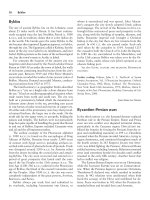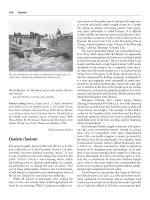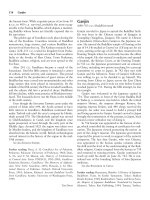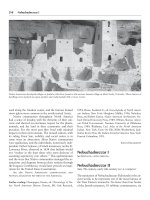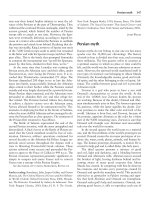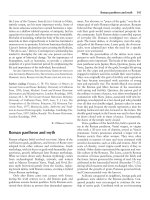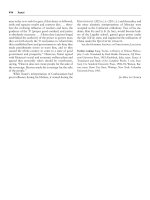Encyclopedia of world history (facts on file library of world history) 7 volume set ( PDFDrive ) 2466
Bạn đang xem bản rút gọn của tài liệu. Xem và tải ngay bản đầy đủ của tài liệu tại đây (96.26 KB, 1 trang )
186
Kerensky, Alexander Fyodorovich
The era of party government was marked by an
increase in public scandals and allegations of corruption that damaged the prestige of the parties, as did
the occasionally unseemly conduct of rival party representatives on the floor of the Diet, including physical assaults. Party government also came under heavy
criticism from rightist elements who felt that such a
parliamentary system ran fundamentally counter to
traditional Japanese values. With disenchantment
toward party officials now spreading on all sides, popular acceptance or toleration of the existing system
was tenuous in an atmosphere of national crisis, and
military officials and members of “patriotic societies”
were able to undermine the role of the parties in governance.
In late 1931 the Seiyukai again gained control
of the government from the Minseito, but it would
prove to be a short-lived cabinet. The maneuvering
of antiparty elements, culminating in May 1932 with
the assassination of prime minister Inukai Tsuyoshi,
resulted in the fall of the Seiyukai cabinet. The era
of party rule suddenly ended, as so-called national
unity governments headed by military leaders or nonparty elites eroded the influence of the parties, and
party representatives in the cabinets declined. The
parties continued to function in the Diet, but internal
strife over how best to defend the Diet’s prerogatives
in the face of increasing military authority may have
prevented the parties from asserting themselves more
strongly. As the 1930s progressed the Minseito tended
to hold to its policy of supporting the nonparty cabinets, while the Seiyukai eventually took a more oppositional stance. The parties still managed to cling to
their place in the Diet and even played a vital part in
the ouster of multiple cabinets in the late 1930s and
into 1940. In the latter year, however, Prime Minister
Konoe Fumimaro’s government succeeded in formally
dissolving Japan’s political party organizations in the
name of creating a wartime new order. Former party
officials continued to exercise parliamentary influence
and as such to play a role in political affairs, albeit a
considerably limited one.
Further reading: Berger, Gordon Mark. Parties Out of
Power in Japan, 1931–1941. Princeton, NJ: Princeton University Press, 1977; Duus, Peter, ed. The Cambridge History
of Japan. Vol 6, The Twentieth Century. Cambridge: Cambridge University Press, 1988; Duus, Peter. Modern Japan.
2d ed. Boston: Houghton Mifflin, 1998; Hastings, Sally Ann.
Neighborhood and Nation in Tokyo, 1905–1937. Pittsburgh: University of Pittsburgh Press, 1995; Najita, Tetsuo.
Hara Kei and the Politics of Compromise, 1905–1915. Cambridge, MA: Harvard University Press, 1967.
Adam C. Stanley
Kerensky, Alexander Fyodorovich
(1881–1970) Russian revolutionary leader
Alexander Kerensky played a key role in toppling the
czarist monarchy immediately before Vladimir Lenin’s Bolsheviks seized power in 1917.
Kerensky, the son of a headmaster, was born in
Simbirsk (now Ulyanovsk), which was also Lenin’s
birthplace. Kerensky graduated in law from Saint
Petersburg University in 1904. In 1905, Kerensky joined
the Socialist Revolutionary Party and became editor of
a radical newspaper. He was arrested and exiled but
returned to Saint Petersburg in 1906 and worked as a
lawyer, demonstrating his political sympathies by his
frequent defense of accused revolutionaries. In 1912,
he was elected to the duma, imperial Russia’s central
parliament, as a member of the Moderate Labor Party.
He was nominated to the Provisional Committee as a
leader of the opposition to Czar Nicholas II.
Unlike many radical socialist leaders, Kerensky supported Russia’s entrance into World War I in 1914.
However, he became more and more disappointed with
the czar’s unsuccessful conduct of the war. Kerensky
was dismayed by the weakness of the czar’s command
of the Russian troops. When the February Revolution
broke out in 1917, Kerensky urged the removal of
Nicholas II. To Kerensky’s enthusiasm, he was elected
vice chairman of the Saint Petersburg Soviet. When the
czar abdicated on March 13, the duma formed a provisional government. Kerensky was appointed minister
of justice and instituted a series of reforms, including
civil liberties such as freedom of speech, assembly, and
the press, as well as the abolition of ethnic and religious discrimination. He made plans for the introduction of universal suffrage. He became a widely known
and popular figure among the revolutionary leaders.
Handed the war and navy ministry in May 1917,
Kerensky was determined to ensure Russia’s continued participation in the Allied war effort. He toured
the front, where he made a series of inspiring speeches
appealing to the demoralized troops to continue fighting. Kerensky subsequently planned a new offensive
against Germany and Austria-Hungary. Encouraged
by the Bolsheviks, there were mass demonstrations
against Kerensky in Petrograd. The July 1 Offensive,

